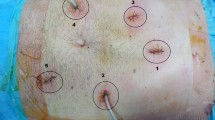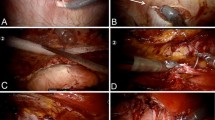Abstract
Background
Lateral abdominal wall hernias (LAWH) constitute about 1–4% of hernia surgical procedures. They represent a unique surgical challenge on account of their potential for anatomical complexity and consequent operative technical demand. Furthermore, LAWH repairs are currently not standardized, and remain contentious, despite a variety of approaches. These repairs are attendant with not insignificant morbidity and recurrence rates. We profile here our endoscopic and hybrid surgical approach to the management of LAWH and early therapeutic outcomes.
Methods
A retrospective review of our hernia clinical database between March 2018 and December 2020 was performed to extract all LAWH (with and without an associated midline component) patients, who underwent an enhanced-view totally extra peritoneal (eTEP) hernia repair with a transversus abdominis release (TAR), or a hybrid repair. Initial outcome data (6-month follow-up) is profiled here. The primary outcome measures were hernia recurrence and hernia-site bulging. The secondary measures were surgical site occurrence (SSO) and hernia-related quality of life (QoL).
Results
A total of 33 LAWH patients underwent an eTEP TAR or hybrid hernia repair. 11 patients had an associated midline defect and 12 were recurrent hernias. The mean hernia defect area was 84.2 ± 49 cm2 and mean mesh size was 859.6 ± 263 cm2. There was no hernia recurrence at initial follow-up of 24 months. The SSO rate was 12%. The CCS QoL scores were 34.6 ± 2 pre-operatively, and improved to 27.2 ± 4 at 6 months.
Conclusions
Our endoscopic and hybrid technique is a safe, reproducible, and technically promising approach for the repair of LAWH. Thorough knowledge of the surgical anatomy of the lateral abdominal wall and advanced endosurgical skills are imperative for good outcomes. We await the long-term results of our LAWH cohort to confirm the findings.








Similar content being viewed by others
References
Katkhouda N, Alicuben ET, Pham V (2020) Management of lateral abdominal hernias. Hernia 24:353–358
Kapur SK, Butler CE (2018) Lateral abdominal wall reconstruction. Semin Plast Surg 32(3):141–146. https://doi.org/10.1055/s-0038-1666801
Baumann DP, Butler CE (2012) Lateral abdominal wall reconstruction. Semin Plast Surg 26(1):40–48. https://doi.org/10.1055/s-0032-1302465
Stamatiou D, Skandalakis JE, Skandalakis LJ, Mirilas P (2009) Lumbar hernia: surgical anatomy, embryology, and technique of repair. Am Surg 75(3):202–207
Moreno-Egea A, Baena EG, Calle MC, Martinez JA, Albasini JL (2007) Controversies in the current management of lumbar hernias. Arch Surg 142(1):82–88. https://doi.org/10.1001/archsurg.142.1.82
Befa LR, Margiotta AL, Carbonell AM (2018) Flank and lumbar hernia repair. Surg Clin North Am 98(3):593–605. https://doi.org/10.1016/j.suc.2018.01.009
Ventral Hernia Working Group, Breuing K, Butler CE et al (2010) Incisional ventral hernias review of the literature and recommendations regarding the grading and technique of repair. Surgery 148:544–558
Mangram AJ, Horan TC, Pearson ML et al (1999) (1999) Guideline for prevention of surgical site infection, Hospital Infection Control Practices Advisory Committee. Infect Control Hosp Epidemiol 20:250–278
Muysoms FE, Miserez M, Berrevoet F et al (2009) Classifcation of primary and incisional abdominal wall hernias. Hernia 13(4):407–414
Belyansky I, Ramana B et al (2017) A novel approach using the enhanced-view totally extraperitoneal (eTEP) technique for laparoscopic retromuscular hernia repair. Surg Endosc 32:1531–1532
Khetan M, Ramana B et al (2021) eTEP repair for midline primary and incisional hernia: technical considerations and initial experience. Hernia. https://doi.org/10.1007/s10029-021-02397-6
Gibreel W, Sarr MG, Rosen M, Novitsky Y (2016) Technical considerations in performing posterior component separation with transverse abdominis muscle release. Hernia. https://doi.org/10.1007/s10029-016-1473-Y
Halm JA, Lip H, Schmitz PI, Jeekel J (2009) Incisional hernia after upper abdominal surgery: a randomized controlled trial of midline versus transverse incision. Hernia 13(3):275–280. https://doi.org/10.1007/s10029-008-0469-7
Greenall MJ, Evans M, Pollock AV (1980) Midline or transverse laparotomy? A random controlled clinical trial. Part II: influence on postoperative pulmonary complications. Br J Surg 67(3):191–194
Kendall SW, Brennan TG, Guillou PJ (1991) Suture length to wound length ratio and the integrity of midline and lateral paramedian incisions. Br J Surg 78(6):705–707
Cavalli M, Aiolfi A, Morlacchi A, Bruni PG, Del Ferraro S, Manfredini L, Campanelli G (2021) An extraperitoneal approach for complex flank, iliac, and lumbar hernia. Hernia 25(2):535–544. https://doi.org/10.1007/s10029-020-02214-6
Heniford BT, Iannitti DA, Gagner M (1997) Laparoscopic inferior and superior lumbar hernia repair. Arch Surg 132(10):1141–1144
Moreno-Egea A, Carrillo A, Aguayo JL (2008) Midline versus nonmidline laparoscopic incisional hernioplasty: a comparative study. Surg Endosc 22(3):744–749. https://doi.org/10.1007/s00464-007-9480-9
Dakin GK, Kendrick ML (2013) Challenging hernia locations: flank hernias. The SAGES manual of hernia repair. Springer, Berlin, pp 531–540
Phillips MS, Krpata DM, Blatnik JA, Rosen MJ (2012) Retromuscular preperitoneal repair of flank hernias. J Gastrointest Surg 16(8):1548–1553. https://doi.org/10.1007/s11605-012-1890-x
Zhou DJ, Carlson MA (2018) Incidence, etiology, management, and outcomes of flank hernia: review of published data. Hernia 22(2):353–361
Edwards C, Geiger T, Bartow K et al (2009) Laparoscopic transperitoneal repair of flank hernias: a retrospective review of 27 patients. Surg Endosc 23(12):2692–2696
Zieren J, Menenakos C, Taymoorian K, Muller JM (2007) Flank hernia and bulging after open nephrectomy: mesh repair by flank or median approach? Report of a novel technique. Int Urol Nephrol 39(4):989–993
Nielsen MF, de Beaux A, Damaskos D, Tulloh B (2019) Peritoneal flap hernioplasty for reconstruction of transverse incisional hernia. Hernia. https://doi.org/10.1007/s10029-019-02099-0
Patel PP, Warren JA, Mansour R, Cobb WS, Carbonel AM (2016) A large single-center experience of open lateral abdominal wall hernia repairs. Am Surg 82(7):608–615
Welty G, Klinge U, Klosterhalfen B, Kasperk R, Schumpelick V (2001) Functional impairment and complaints following incisional hernia repair with different polypropylene meshes. Hernia 5(3):142–147
Hofman RS, Smink DS, Noone RB, Noone RB Jr, Smink RD Jr (2004) Surgical repair of the abdominal bulge: correction of a complication of the flank incision for retroperitoneal surgery. J Am Coll Surg 199(5):830–835
Luc G, David A, Couzi L, Midy D, Collet D, Dubuisson V (2014) Lateral incisional hernia after renal transplantation: a comparative study. World J Surg 38(11):2791–2796
Purnell CA, Park E, Turin SY, Dumanian GA (2016) Postoperative flank defects, hernias and bulges: a reliable method for repair. Plas Reconstr Surg 137(3):994–1001
Veyrie N, Poghosyan T, Corigliano N, Canard G, Servajean S, Bouillot JL (2013) Lateral incisional hernia repair by retromuscular approach with polyester standard mesh; topographic considerations and long-term follow-up of 61 consecutive patients. World J Surg 37(3):538–544
Kaafarani HM, Hur K, Hirter A, Kim LT, Thomas A, Berger DH, Reda D, Itani KM (2009) Seroma in ventral incisional herniorrhaphy: incidence, predictors and outcome. Am J Surg 198(5):639–644
Pring CM, Tran V, O’Rourke N, Martin IJ (2008) Laparoscopic versus open ventral hernia repair: a randomized controlled trial. ANZ J Surg 78(10):903–906
Author information
Authors and Affiliations
Corresponding author
Ethics declarations
Conflict of interest
All authors Mukund Khetan, Sudhir Kalhan, Suviraj John, Daksh Sethi, Pankaj Kannaujiya and Ramana Balasubramaniam have no relevant conflicts of interest or financial ties to disclose.
Ethical approval
All authors certify that they accept responsibility as an author and have contributed to the concept, data gathering, analysis, manuscript drafting, and give their final approval. This retrospective study was approved by local ethical committee as per the specific requirements of the country.
Informed consent
Informed consent of the patients is not possible as being a retrospective analysis of already available data.
Additional information
Publisher's Note
Springer Nature remains neutral with regard to jurisdictional claims in published maps and institutional affiliations.
Rights and permissions
Springer Nature or its licensor holds exclusive rights to this article under a publishing agreement with the author(s) or other rightsholder(s); author self-archiving of the accepted manuscript version of this article is solely governed by the terms of such publishing agreement and applicable law.
About this article
Cite this article
Khetan, M., Kalhan, S., John, S. et al. MIS retromuscular repair of lateral incisional hernia: technological deliberations and short-term outcome. Hernia 26, 1325–1336 (2022). https://doi.org/10.1007/s10029-022-02671-1
Received:
Accepted:
Published:
Issue Date:
DOI: https://doi.org/10.1007/s10029-022-02671-1




